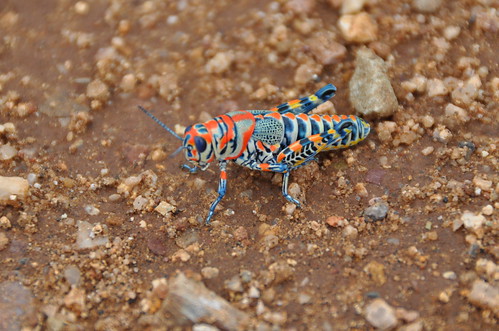Bright colors = bad taste in nature if you flaunt yourself like that it usually means you are poisonous or not that tasty anyway. It is called Aposematic coloration.
I have a lot of success getting orthopterans from the Arizona area to oviposit in dry coco fiber substrate but i always offer sandy soil mixes and straight topsoil and let the animal choose what they like the best. Good luck with your rainbow grasshoppers.
I agree, Tony, that anyone seeing this grasshopper out in the open would think that such bright coloration would have to be a warning, though in fact, I don't think that there is any evidence that this grasshopper tastes bad. I live in Yuma county which shares the southern strip of AZ with Pima county, all the way to Tucson, and it is not particuarly uncommon to find them here. You will notice them flying, but when they land and "freeze", they blend in with the scrub background very well, so i think that theirs may be protective coloration. My view is shared by a graduate entomology student who has also seen them in the wild. I must write her and invite her to join MantidForum after posting this.
Here, though, is another possibility that is entirely speculative but interesting none the less. I have noted the black and white stripes on this grasshopper's femora, and it reminded me of the confusing camouflage presented by the stripes of a group of zebras, but the predominant colors here are red and blue. Some years ago, hundred of Japanese children developed headaches and confusion, and a few even seized after watching a kids' show that showed a face with flashing blue and red lights. That evening, there was a rerun and the same thing happened again:
http://webcache.goog...lient=firefox-a
(Scroll down until you see the blue face, and observe the warning!)
This is a migratory species, and I wonder if the flashing red and blue colors of a bunch of these critters might not have the same effect on predatory birds, who have tetrachromic vision like ours. Would that be cool, or what?













































